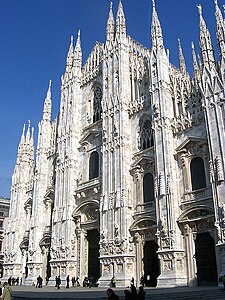White Men Can't Jump Sydney You Have a Family
| White | |
|---|---|
| | |
| | |
| Hex triplet | #FFFFFF |
| sRGB B (r, chiliad, b) | (255, 255, 255) |
| HSV (h, due south, v) | (0°, 0%, 100%) |
| CIELChuv (L, C, h) | (100, 0, 0°) |
| Source | [Unsourced] |
| B: Normalized to [0–255] (byte) | |
White is the lightest colour and is achromatic (having no hue). It is the color of snowfall, chalk, and milk, and is the opposite of black. White objects fully reflect and scatter all the visible wavelengths of light. White on television and computer screens is created past a mixture of blood-red, blue, and green light. The color white tin can be given with white pigments, specially titanium dioxide.[one]
Symbolic pregnant
In aboriginal Egypt and ancient Rome, priestesses wore white as a symbol of purity, and Romans wore white togas as symbols of citizenship. In the Eye Ages and Renaissance a white unicorn symbolized chastity, and a white lamb sacrifice and purity. It was the royal colour of the kings of France, and of the monarchist movement that opposed the Bolsheviks during the Russian Civil War (1917–1922). Greek and Roman temples were faced with white marble, and beginning in the 18th century, with the advent of neoclassical compages, white became the virtually common colour of new churches, capitols and other regime buildings, specially in the United states of america. Information technology was also widely used in 20th century modern architecture as a symbol of modernity and simplicity.
Co-ordinate to surveys in Europe and the United States, white is the colour most often associated with perfection, the skilful, honesty, cleanliness, the beginning, the new, neutrality, and exactitude.[2] White is an important color for almost all world religions. The pope, the caput of the Roman Catholic Church, has worn white since 1566, every bit a symbol of purity and sacrifice. In Islam, and in the Shinto faith of Japan, it is worn by pilgrims. In Western cultures and in Japan, white is the nearly common color for nuptials dresses, symbolizing purity and virginity. In many Asian cultures, white is besides the color of mourning.[3]
Etymology
The word white continues Old English hwīt , ultimately from a Mutual Germanic *χdue westītaz also reflected in OHG (h)wîz , ON hvítr , Goth. ƕeits . The root is ultimately from Proto-Indo-European linguistic communication *kdue westid- , surviving also in Sanskrit śveta "to be white or bright"[4] and Slavonic světŭ "low-cal".[five] [6] The Icelandic word for white, hvítur , is directly derived from the Old Norse form of the word hvítr . Common Germanic also had the give-and-take *blankaz ("white, bright, blinding"), borrowed into Belatedly Latin every bit *blancus, which provided the source for Romance words for "white" (Catalan, Occitan and French blanc, Castilian blanco, Italian bianco, Galician-Portuguese branco, etc.). The antonym of white is black.
Some non-European languages accept a wide variety of terms for white. The Inuit language has 7 dissimilar words for 7 different nuances of white. Sanskrit has specific words for bright white, the white of teeth, the white of sandalwood, the white of the autumn moon, the white of silver, the white of cow's milk, the white of pearls, the white of a ray of sunlight, and the white of stars. Japanese has six dissimilar words, depending upon brilliance or dullness, or if the colour is inert or dynamic.[vii]
History and art
Prehistoric and ancient history
White was one of the first colors used in art. The Lascaux Cavern in French republic contains drawings of bulls and other animals drawn by paleolithic artists between xviii,000 and 17,000 years ago. Paleolithic artists used calcite or chalk, sometimes as a background, sometimes equally a highlight, along with charcoal and red and yellowish ochre in their vivid cave paintings.[8] [9]
In aboriginal Egypt, white was connected with the goddess Isis. The priests and priestesses of Isis dressed merely in white linen, and information technology was used to wrap mummies.[10]
In Hellenic republic and other ancient civilizations, white was oftentimes associated with female parent's milk. In Greek mythology, the main god Zeus was nourished at the breast of the nymph Amalthea. In the Talmud, milk was one of four sacred substances, forth with wine, honey, and the rose.[xi]
The ancient Greeks saw the globe in terms of darkness and low-cal, so white was a cardinal color. According to Pliny the Elder in his Natural History, Apelles (4th century BC) and the other famous painters of ancient Greece used only iv colors in their paintings; white, red, yellow and black;[12] For painting, the Greeks used the highly toxic pigment lead white, made by a long and laborious procedure.[13]
A evidently white toga, known as a toga virilis, was worn for ceremonial occasions past all Roman citizens over the age of 14–18. Magistrates and certain priests wore a toga praetexta, with a broad majestic stripe. In the time of the Emperor Augustus, no Roman man was immune to appear in the Roman forum without a toga.
The ancient Romans had two words for white; albus, a plain white, (the source of the word albino); and candidus, a brighter white. A man who wanted public part in Rome wore a white toga brightened with chalk, chosen a toga candida, the origin of the discussion candidate. The Latin discussion candere meant to polish, to be bright. Information technology was the origin of the words candle and candid.[14]
In ancient Rome, the priestesses of the goddess Vesta dressed in white linen robes, a white palla or shawl, and a white veil. They protected the sacred burn and the penates of Rome. White symbolized their purity, loyalty, and chastity.[ten]
-

Prehistoric paintings in Chauvet Cave, France (30,000 to 32,000 BC)
-

Painting of the goddess Isis (1380–1385 BC). The priests of her cult wore white linen.
-
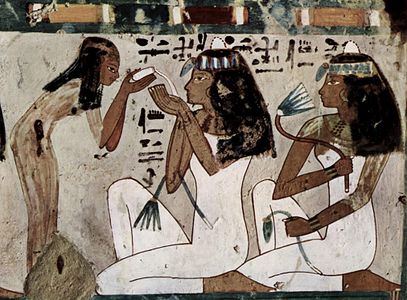
Paintings of women in white from a tomb (1448–1422 BC).
Postclassical history
The early on Christian church adopted the Roman symbolism of white as the colour of purity, sacrifice and virtue. It became the colour worn by priests during Mass, the color worn by monks of the Cistercian Order, and, nether Pope Pius V, a former monk of the Dominican Lodge, it became the official color worn by the pope himself. Monks of the Order of Saint Benedict dressed in the white or gray of natural undyed wool, but later changed to blackness, the color of humility and penitence.
Postclassical history art, the white lamb became the symbol of the cede of Christ on behalf of mankind. John the Baptist described Christ as the lamb of God, who took the sins of the globe upon himself. The white lamb was the heart of one of the most famous paintings of the Medieval catamenia, the Ghent Altarpiece by Jan van Eyck.[15]
White was as well the symbolic colour of the transfiguration. The Gospel of Saint Mark describes Jesus' habiliment in this consequence every bit "shining, exceeding white every bit snow." Artists such as Fra Angelico used their skill to capture the whiteness of his garments. In his painting of the transfiguration at the Convent of Saint Mark in Florence, Fra Angelico emphasized the white garment past using a light gilt background, placed in an almond-shaped halo.[16]
The white unicorn was a mutual subject of Postclassical history manuscripts, paintings and tapestries. Information technology was a symbol of purity, chastity and grace, which could only be captured by a virgin. It was often portrayed in the lap of the Virgin Mary.[17]
During the Postclassical history, painters rarely ever mixed colors; but in the Renaissance, the influential humanist and scholar Leon Battista Alberti encouraged artists to add white to their colors to make them lighter, brighter, and to add hilaritas, or gaiety. Many painters followed his advice, and the palette of the Renaissance was considerably brighter.[18]
Modern history
Until the 16th century, white was usually worn past widows every bit a color of mourning. The widows of the kings of French republic wore white until Anne of Brittany in the 16th century. A white tunic was as well worn by many knights, along with a red cloak, which showed the knights were willing to give their claret for the king or Church building.
-

The monks of the gild of Saint Bridegroom (circa 480–542) first dressed in undyed white or gray wool robes, here shown in painting by Sodoma on the life of Saint Bridegroom (1504). They later changed to black robes, the color of humility and penitence.
-
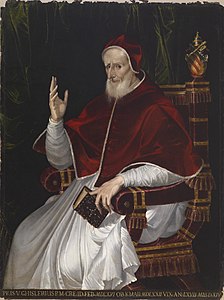
Under Pope Pius 5 (1504–1572), a old monk of the Dominican Order, white became the official color worn past the Pope.
-
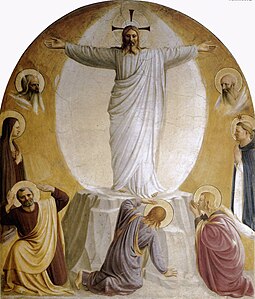
18th and 19th centuries
White was the ascendant colour of architectural interiors in the Baroque catamenia and especially the Rococo fashion that followed it in the 18th century. Church interiors were designed to show the power, glory and wealth of the church. They seemed to be alive, filled with curves, asymmetry, mirrors, gilding, statuary and reliefs, unified by white.
White was also a fashionable colour for both men and women in the 18th century. Men in the aristocracy and upper classes wore powdered white wigs and white stockings, and women wore elaborate embroidered white and pastel gowns.
Subsequently the French Revolution, a more than austere white (blanc cassé) became the most fashionable color in women's costumes which were modeled after the outfits of Ancient Greece and Republican Rome. Because of the rather revealing design of these dresses, the ladies wearing them were called les merveilleuses (the marvellous) past French men of that era.[19] The Empire style under Emperor Napoléon I was modeled after the more bourgeois outfits of Ancient Imperial Rome. The dresses were high in way but low in warmth considering the more severe weather atmospheric condition of northern France; in 1814 the sometime wife of Napoleon, Joséphine de Beauharnais, caught pneumonia and died later on taking a walk in the common cold night air with Tsar Alexander I of Russia.[twenty]
White was the universal color of both men and women'south underwear and of sheets in the 18th and 19th centuries. It was unthinkable to accept sheets or underwear of any other color. The reason was elementary; the mode of washing linen in boiling water caused colors to fade. When linen was worn out, it was collected and turned into high-quality paper.[21]
The 19th-century American painter James McNeill Whistler (1834–1903), working at the same time as the French impressionists, created a series of paintings with musical titles where he used color to create moods, the mode composers used music. His painting Symphony in White No. 1 – The White Girl, which used his mistress Joanna Hiffernan as a model, used delicate colors to portray innocence and fragility, and a moment of uncertainty.[22]
-

-
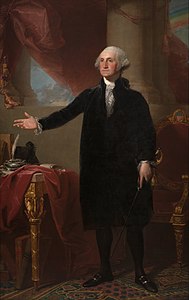
President George Washington in a white powdered wig. The showtime five Presidents of the United States wore night suits with powdered wigs for formal occasions.
20th and 21st centuries
The White movement was the opposition that formed against the Bolsheviks during the Russian Civil State of war, which followed the Russian Revolution in 1917. It was finally defeated past the Bolsheviks in 1921–22, and many of its members emigrated to Europe.
At the end of the 19th century, lead white was still the most pop pigment; just between 1916 and 1918, chemical companies in Norway and the United states began to produce titanium white, made from titanium oxide. It had first been identified in the 18th century past the German language chemist Martin Klaproth, who as well discovered uranium. It had twice the covering ability of pb white, and was the brightest white paint known. By 1945, 80 pct of the white pigments sold were titanium white.[23]
The absoluteness of white appealed to modernist painters. It was used in its simplest class by the Russian suprematist painter Kazimir Malevich in his 1917 painting 'the white square,' the companion to his earlier 'black square.' It was as well used past the Dutch modernist painter Piet Mondrian. His most famous paintings consisted of a pure white canvass with grid of vertical and horizontal black lines and rectangles of primary colors.
Black and white also appealed to modernist architects, such as Le Corbusier (1887–1965). He said a house was "a machine for living in" and chosen for a "calm and powerful architecture" built of reinforced concrete and steel, without whatever decoration or frills.[24] Almost all the buildings of contemporary architect Richard Meier, such as his museum in Rome to house the aboriginal Roman Ara Pacis, or Altar of Peace, are stark white, in the tradition of Le Corbusier.
-

Affiche for the White Ground forces during the Russian Civil War (1917–22). The poster says: "for a United Russia."
-

The Villa Savoye (1928–31) by Le Corbusier; Le Corbusier chosen for a "calm and powerful" architecture built of steel and reinforced concrete, without color or ornament.
Scientific agreement (Colour science)
Light is perceived by the human visual system equally white when the incoming light to the eye stimulates all three types of color sensitive cone cells in the center in roughly equal amounts.[25] Materials that exercise not emit light themselves appear white if their surfaces reflect back nearly of the low-cal that strikes them in a lengthened style.
White light
-

In the RGB colour model, used to create colors on Tv set and computer screens, white is made by mixing reddish, blue and greenish calorie-free at total intensity.
In 1666, Isaac Newton demonstrated that white low-cal was equanimous of multiple colors by passing it through a prism to break information technology upwardly into components then using a second prism to reassemble them. Before Newton, near scientists believed that white was the fundamental color of light.[26]
White calorie-free can be generated past the sun, by stars, or by earthbound sources such as fluorescent lamps, white LEDs and incandescent bulbs. On the screen of a colour television or computer, white is produced by mixing the main colors of light: red, green and blue (RGB) at total intensity, a procedure called additive mixing (meet epitome below). White light tin be made using low-cal with just ii wavelengths, for instance by mixing light from a red and cyan laser or yellow and blue lasers. This calorie-free volition however have very few applied applications since color rendering of objects volition be greatly distorted.
The fact that light sources with vastly different spectral ability distributions tin can outcome in a like sensory experience is due to the way the low-cal is processed by the visual system. Ane colour that arises from two different spectral ability distributions is called a metamerism.
Many of the light sources that emit white light emit low-cal at almost all visible wavelengths (sun light, incandescent lamps of various Color temperatures). This has led to the notion that white light can be defined as a mixture of "all colors" or "all visible wavelengths".[27] [28] This widespread idea is a misconception,[ citation needed ] and might originally stem from the fact that Newton discovered that sunlight is equanimous of low-cal with wavelengths across the visible spectrum. Concluding that since "all colors" produce white lite then white must exist made up of "all colors" is a mutual logical error called affirming the consequent, which might be the cause of the misunderstanding.
A range of spectral distributions of light sources can be perceived equally white—there is no single, unique specification of "white low-cal". For example, when ownership a "white" light bulb, one might purchase one labeled 2700K, 6000K, etc., which produce low-cal having very different spectral distributions, and nonetheless this will not forestall the user from identifying the color of objects that those light bulbs illuminate.[29]
White objects
Color vision allows united states to distinguish different objects by their colour. In order to practise so, color constancy can go along the perceived color of an object relatively unchanged when the illumination changes among various wide (whitish) spectral distributions of low-cal.[29]
The same principle is used in photography and cinematography where the selection of white point determines a transformation of all other color stimuli. Changes in or manipulation of the white signal can exist used to explain some optical illusions such as The dress.
While in that location is no single, unique specification of "white light", there is indeed a unique specification of "white object", or, more specifically, "white surface". A perfectly white surface diffusely reflects (scatters) all visible light that strikes information technology, without arresting whatever, irrespective of the light's wavelength or spectral distribution.[30] [31] Since it does not absorb any of the incident light, white is the lightest possible color. If the reflection is not diffuse but rather specular, this describes a mirror rather than a white surface.[32] [thirty]
Reflection of 100% of incident light at all wavelengths is a form of uniform reflectance, so white is an achromatic color, meaning a color without hue.[33] [34] The colour stimulus produced by the perfect diffuser is usually considered to exist an achromatic stimulus for all illuminants, except for those whose light sources announced to exist highly chromatic.[35]
Color constancy is accomplished past chromatic adaptation. The International Commission on Illumination defines white (adapted) every bit "a color stimulus that an observer who is [chromatically] adapted to the viewing environment would approximate to exist perfectly achromatic and to have a luminance factor of unity. The colour stimulus that is considered to be the adapted white may be different at different locations within a scene.[36]
White features in nature
-
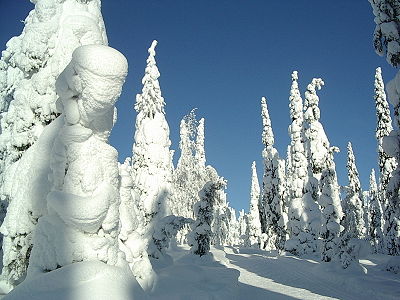
Snow is composed of ice and air; information technology scatters or reflects sunlight without arresting other colors of the spectrum.
-

Cumulus clouds look white because the h2o droplets reflect and scatter the sunlight without absorbing other colors.
-
Beaches with sand containing high amounts of quartz or eroded limestone besides appear white, since quartz and limestone reflect or besprinkle sunlight, rather than absorbing it. Tropical white sand beaches may also have a loftier quantity of white calcium carbonate from tiny bits of seashells ground to fine sand by the action of the waves.[37]
The White Cliffs of Dover accept their white color from the large amount of chalk, made of limestone, which they comprise, which reflects the sunlight.
Snow is a mixture of air and tiny ice crystals. When white sunlight enters snow, very trivial of the spectrum is captivated; near all of the light is reflected or scattered by the air and water molecules, and then the snowfall appears to be the color of sunlight, white. Sometimes the low-cal bounces around inside the ice crystals earlier existence scattered, making the snowfall seem to sparkle.[38]
In the case of glaciers, the water ice is more tightly pressed together and contains little air. Every bit sunlight enters the ice, more than light of the scarlet spectrum is absorbed, and so the low-cal scattered will be bluish.[39]
Clouds are white for the same reason as water ice. They are composed of h2o droplets or ice crystals mixed with air, very lilliputian low-cal that strikes them is captivated, and most of the light is scattered, appearing to the middle as white. Shadows of other clouds in a higher place can make clouds look gray, and some clouds take their own shadow on the bottom of the cloud.[twoscore]
Many mountains with winter or year-round snow cover are named accordingly: Mauna Kea means white mount in Hawaiian, Mont Blanc means white mountain in French. Changbai Mountains literally pregnant perpetually white mountains, marks the border between China and Korea.
White materials
-
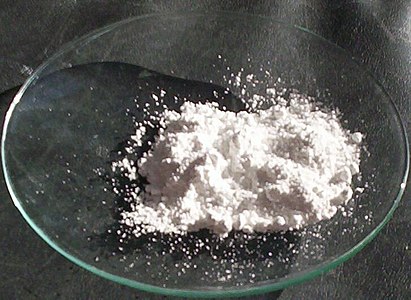
Titanium white, made with titanium dioxide, is the brightest white paint available. Information technology also colors virtually toothpaste and sunscreen.
Chalk is a type of limestone, made of the mineral calcite, or calcium carbonate. It was originally deposited under the sea as the scales or plates of tiny micro-organisms called Coccolithophore. Information technology was the get-go white pigment used by prehistoric artists in cave paintings. The chalk used on blackboards today is usually fabricated of gypsum or calcium sulphate, a powder pressed into sticks.
Bianco di San Giovanni is a pigment used in the Renaissance, which was described past the painter Cennino Cennini in the 15th century. It is similar to chalk, made of calcium carbonate with calcium hydroxide. It was made of stale lime which was made into a powder, and then soaked in water for 8 days, with the water inverse each twenty-four hour period. It was and so fabricated into cakes and stale in the sun.[41]
Atomic number 82 white was existence produced during the quaternary century BC; the process is described is Pliny the Elder, Vitruvius and the ancient Greek writer Theophrastus. Pieces of lead were put into clay pots which had a separate compartment filled with vinegar. The pots in turn were piled on shelves close to moo-cow dung. The combined fumes of the vinegar and the cow dung caused the pb to corrode into lead carbonate. It was a slow process which could take a calendar month or more. It made an fantabulous white and was used past artists for centuries, just it was also toxic. It was replaced in the 19th century by zinc white and titanium white.[42]
Titanium white is the most pop white for artists today; it is the brightest bachelor white pigment, and has twice the coverage of lead white. It first became commercially available in 1921. It is made out of titanium dioxide, from the minerals brookite, anatase, rutile, or ilmenite, currently the major source. Considering of its vivid whiteness, information technology is used as a colorant for most toothpaste and sunscreen.[43]
Zinc white is fabricated from zinc oxide. It is like to simply not as opaque as titanium white. It is added to some foods to enrich them with zinc, an of import food.[44] Chinese white is a variety of zinc white made for artists.[45]
Some materials can be fabricated to look "whiter than white", this is achieved using optical brightener agents (OBA). These are chemical compounds that absorb calorie-free in the ultraviolet and violet region (usually 340–370 nm) of the electromagnetic spectrum, and re-emit light in the blue region (typically 420–470 nm). OBAs are oft used in paper and article of clothing to create an impression of very bright white. This is due to the fact that the materials really send out more than visible light than they receive.
Bleach and bleaching
Bleaching is a process for whitening fabrics which has been practiced for thousands of years. Sometimes information technology was but a matter of leaving the fabric in the sun, to be faded by the vivid light. In the 18th century several scientists developed varieties of chlorine bleach, including sodium hypochlorite and calcium hypochlorite (bleaching powder).[46] Bleaching agents that practise not contain chlorine most often are based on peroxides, such as hydrogen peroxide, sodium percarbonate and sodium perborate. While almost bleaches are oxidizing agents, a fewer number are reducing agents such every bit sodium dithionite.
Bleaches attack the chromophores, the part of a molecule which absorbs low-cal and causes fabrics to have dissimilar colors. An oxidizing bleach works by breaking the chemical bonds that make upwards the chromophore. This changes the molecule into a different substance that either does not contain a chromophore, or contains a chromophore that does not absorb visible light. A reducing bleach works by converting double bonds in the chromophore into single bonds. This eliminates the ability of the chromophore to absorb visible light.[47]
Sunlight acts as a bleach through a similar process. High energy photons of lite, often in the violet or ultraviolet range, tin can disrupt the bonds in the chromophore, rendering the resulting substance colorless.[48]
Some detergents become one footstep further; they contain fluorescent chemicals which glow, making the fabric expect literally whiter than white.[49]
In the natural world
Astronomy

Image of Sirius A and Sirius B taken by the Hubble Space Telescope. Sirius B, a white dwarf, is the faint pinprick of light to the lower left of the much brighter Sirius A.
A white dwarf is a stellar remnant composed mostly of electron-degenerate affair. They are very dumbo; a white dwarf's mass is comparable to that of the Dominicus and its volume is comparable to that of the World. Its faint luminosity comes from the emission of stored thermal energy. A white dwarf is very hot when it is formed, but since it has no source of energy, it volition gradually radiate away its energy and cool down. This means that its radiation, which initially has a loftier colour temperature, will lessen and redden with time. Over a very long fourth dimension, a white dwarf will absurd to temperatures at which it will no longer emit pregnant oestrus or lite, and information technology will become a cold black dwarf.[50] However, since no white dwarf can exist older than the Age of the universe (approximately xiii.8 billion years),[51] fifty-fifty the oldest white dwarfs still radiate at temperatures of a few grand kelvins, and no black dwarfs are thought to exist yet.
An A-type main-sequence star (A Five) or A dwarf star is a main-sequence (hydrogen-burning) star of spectral type A and luminosity course Five. These stars accept spectra which are defined by strong hydrogen Balmer absorption lines.[52] [53] They accept masses from 1.4 to two.1 times the mass of the Sun and surface temperatures between 7600 and 11 500 M.[54]
Biology
White animals use their color as a form of cover-up in winter.
-
The dove is an international symbol of peace.
-

The ermine, or stoat. In one case considered the most noble of animals because it would rather dice than dirty its fur.
-
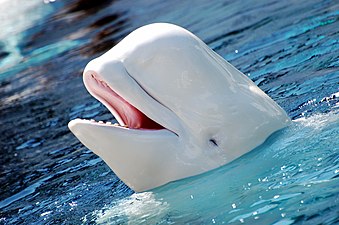
The Beluga whale lives in Arctic and sub-arctic waters, where its color is an constructive camouflage
-

A Polar Deport in Alaska. Its color is a form of camouflage
Organized religion and civilization
-

Thousands of pilgrims in white gather in Mecca for the beginning of their pilgrimage, or Hajj.
-
A pilgrim in Nippon.
-

The Buddhist deity Tara is often depicted with white skin.
White is an important symbolic color in well-nigh religions and cultures, commonly considering of its association with purity.
In the Roman Cosmic Church building, white is associated with Jesus Christ, innocence and cede. Since the Middle Ages, priests wear a white cassock in many of the about important ceremonies and religious services connected with events in the life of Christ. White is worn by priests at Christmas, during Easter, and during celebrations continued with the other events of the life of Christ, such as Corpus Christi Sun, and Trinity Lord's day. It is also worn at the services dedicated to the Virgin Mary, and to those Saints who were not martyred, as well as other special occasions, such every bit the ordination of priests and the installation of new bishops. Within the hierarchy of the church, the lighter the color, the college the rank. Ordinary priests wear black; bishops article of clothing violet, cardinals article of clothing red, and exterior a church building, only the Pope volition vesture white.[55] Popes occasionally wore white in the Centre Ages, but usually wore red. Popes have worn white regularly since 1566, when Pope Pius V, a member of the Dominican Social club, began the practice. White is the color of the Dominican Order.
In The Church of Jesus Christ of Latter-mean solar day Saints the colour white is used as a symbol of purity, innocence, and cleanliness, particularly in religious ceremonies such equally baptism[56] and temple ceremonies.[57] In temple ceremonies, white habiliment is likewise worn by all participants, both men and women, to too symbolize unity and equality before God.[58] [59]
In Islam, white clothing is worn during required pilgrimage to Mecca, or Ihram pilgrimage (Hajj).Hajj. Called Ihram clothing, men'southward garments oftentimes consist of two white un-hemmed sheets (commonly towelling textile). The peak (the riḍā) is draped over the torso and the lesser (the izār) is secured by a belt; plus a pair of sandals. Women'due south clothing varies considerably and reflects regional besides as religious influences. Ihram is typically worn during Dhu al-Hijjah, the last calendar month in the Islamic agenda.
White also has a long history of utilise every bit a religious and political symbol in Islam, beginning with the white banner that tradition ascribes to the Quraysh, the tribe to which Muhammad belonged. The Umayyad dynasty also used white as its dynastic color, following the personal banner of its founder, Mu'awiya I, while the Shi'ite Fatimids also chose white to highlight their opposition to the Sunni Abbasid Caliphate, whose color was black.[60]
In Judaism, during the rituals of Yom Kippur, the ceremony of atonement, the rabbi dresses in white, as exercise the members of the congregation, to restore the bonds between God and his followers.
In the traditional Japanese religion of Shinto, an expanse of white gravel or stones marks a sacred place, called a niwa. These places were dedicated to the kami, spirits which had descended from the heavens or had come across the ocean. Later, temples of Zen Buddhism in Nihon often featured a Zen garden, where white sand or gravel was carefully raked to resemble rivers or streams, designed equally objects of meditation.[61]
In the temples of The Church of Jesus Christ of Latter-day Saints (LDS Church or also known as Mormon), White clothing is worn inside once they have been officially dedicated, due to white symbolizing purity.[62]
Many religions symbolize heaven by using a sky with white clouds. This phenomenon is not express to western culture; in Yoruba faith, the orisha Obatala in the Ifá tradition is represented past white. Obatala is associated with calmness, morality, old age, and purity.
In Theosophy and similar religions, the deities called the Dandy White Brotherhood are said to have white auras.[63]
In some Asian and Slavic cultures, white is considered to be a color that represents expiry.[64] White also represented decease in ancient Egypt, representing the lifeless desert that covered much of the country; black was held to be the color of life, representing the mud-covered fertile lands created past the flooding of the Nile and giving the state its name (Kemet, or "black country").
In Cathay, Korea, and some other Asian countries, white, or more precisely, the whitish color of undyed linen, is the colour of mourning and funerals.[65]
In traditional China, undyed linen vesture is worn at funerals. As fourth dimension passes, the bereaved can gradually wearable wear dyed with colors, so with darker colors. Small sacks of quicklime, 1 for each yr of the life of the deceased are placed around the body to protect it against impurity in the next world, and white paper flowers are placed around the body.[66]
In China and other Asian countries, white is the color of reincarnation, showing that decease is not a permanent separation from the world.[67]
In Mainland china, white is associated with the masculine (the yang of the yin and yang); with the unicorn and tiger; with the fur of an fauna; with the direction of westward; with the element metallic; and with the fall season.[68]
In Japan, undyed linen white robes are worn by pilgrims for rituals of purification, and bathing in sacred rivers. In the mountains, pilgrims wear costumes of undyed jute to symbolize purity. A white kimono is often placed in the casket with the deceased for the journeying to the other world, as white represents death sometimes.[69] Condolence gifts, or kooden, are tied with black and white ribbons and wrapped in white paper, protecting the contents from the impurities of the other world.[70]
In Republic of india, it is the color of purity, divinity, detachment and serenity. In Hindi, the name Sweta means white.
In Tibetan Buddhism, white robes were reserved for the lama of a monastery.
In the Bedouin and some other pastoral cultures, at that place is a strong connection between milk and white, which is considered the color of gratitude, esteem, joy, good fortune and fertility.[71]
In Paganism, it is used for peace, innocence, illumination, and purity. It can also be used to stand up for whatsoever color.[72] White is also associated with cleansing, a Infidel exercise that cleans something using the elements. In Wicca, a white-handled knife chosen the boline is used in rituals.[73]
Political movements

White is ofttimes associated with monarchism. The clan originally came from the white flag of the Bourbon dynasty of France. White became the banner of the royalist rebellions against the French Revolution (see Revolt in the Vendée).
During the Civil War which followed the Russian Revolution of 1917, the White Regular army, a coalition of monarchists, nationalists and liberals, fought unsuccessfully against the Red Army of the Bolsheviks. A similar boxing between reds and whites took place during the Ceremonious War in Finland in the same period.
The Ku Klux Klan is a racist and anti-immigrant organization which flourished in the Southern United States after the American Ceremonious War. They wore white robes and hoods, burned crosses and violently attacked and murdered blackness Americans.
In Iran, the White Revolution was a series of social and political reforms launched in 1963 by the last Shah of Iran before his downfall.
White is also associated with peace and passive resistance. The white ribbon is worn by movements denouncing violence confronting women and the White Rose was a non-vehement resistance group in Nazi Federal republic of germany.
Selected national flags featuring white
White is a common color in national flags, though its symbolism varies widely. The white in the flag of the United States and flag of the Uk comes from traditional red St George's Cross on a white groundwork of the historic flag of England. The white in the flag of France represents either the monarchy or "white, the ancient French colour" according to the Marquis de Lafayette.
Many flags in the Arab world utilise the colors of the flag of the Arab Revolt of 1916; carmine, white, green and blackness. These include the flags of Egypt, Palestine, Hashemite kingdom of jordan, Syrian arab republic, State of kuwait and Iraq.
The Philippines also use white as their symbol for unity in their flag.
-

Flag of the Bourbons, royal family of France until the French Revolution and during the restoration of the monarchy afterward.
-

The Flag of Vatican city (1929). The white and gold colors symbolize the colors of the keys to heaven given by Jesus Christ to Saint Peter: the gold of spiritual ability, the white of worldly ability. The keys accept been the Papal symbol since the 13th century.
-

The flag of Republic of india (1947). White represents "calorie-free, the path of truth".[74]
-

The flag of Ireland. According to the Irish regime press part, "The green represents the older Gaelic tradition while the orange represents the supporters of William of Orange. The white in the centre signifies a lasting truce between the 'Orange' and the 'Greenish'. "[75]
Idioms and expressions
- To whitewash something is to muffle an unpleasant reality.
- A white lie is an innocent prevarication told out of politeness.
- White noise is the noise of all the frequencies of sound combined. It is used to cover up unwanted racket.
- A white knight in finance is a friendly investor who steps in to rescue a visitor from a hostile takeover.
- White-neckband workers are those who work in offices, every bit opposed to blue-neckband workers, who work with their hands in factories or workshops.
- A white paper is an authoritative written report on a major outcome by a team of experts; a authorities study outlining policy; or a curt treatise whose purpose is to brainwash manufacture customers. Associating a paper with white may signify clean facts and unbiased information.
- The white feather is a symbol of cowardice, particularly in U.k..[76] It supposedly comes from cockfighting and the belief that a cockerel sporting a white plume in its tail is likely to be a poor fighter. At the beginning of the First Earth War, women in England were encouraged to give white feathers to men who had not enlisted in the British Military machine.[77]
- In the US, a white shoe firm is an older, bourgeois firm, usually in a field such every bit banking or law. The phrase derives from the "white bucks," laced suede or buckskin shoes with red soles, long pop in the Ivy League colleges.[78]
- In Russian federation, the nobility are sometimes described every bit white bone (белая кость, bélaya kost'), commoners every bit black bone.[79]
Associations and symbolism
Innocence and sacrifice
In Western civilization, white is the color most ofttimes associated with innocence, or purity.[80] In the Bible and in Temple Judaism, white animals such as lambs were sacrificed to expiate sins. The white lily is considered the blossom of purity and innocence, and is often associated with the Virgin Mary.
Ancestry
White is the color in Western culture almost frequently associated with beginnings. In Christianity, children are baptized and first have communion wearing white. Christ afterward the Resurrection is traditionally portrayed dressed in white.
Queen Elizabeth 2 wears white when she opens each session of British Parliament. In high gild, debutantes traditionally wear white for their get-go ball.
Weddings
White has long been the traditional color worn past brides at royal weddings, only the white nuptials gown for ordinary people appeared in the 19th century. Before that fourth dimension, most brides wore their all-time Lord's day article of clothing, of whatever color.[81] The white lace nuptials gown of Queen Victoria in 1840 had a large bear upon on the color and fashion of nuptials dresses in both Europe and America downwardly to the present day.
-

The hymeneals dress of Queen Victoria (1840) set the fashion for hymeneals dresses of the Victorian era and for the 20th century.
-

Japanese formal wedding dress still used today.
Cleanliness
White is the colour most associated with cleanliness. Objects which are expected to exist clean, such as refrigerators and dishes, toilets and sinks, bed linen and towels, are traditionally white. White was the traditional color of the coats of doctors, nurses, scientists and laboratory technicians, though nowadays a pale blue or green is frequently used. White is likewise the colour most ofttimes worn by chefs, bakers, and butchers, and the colour of the aprons of waiters in French restaurants.[82]
Ghosts, phantoms and ii of the 4 Horsemen of the Apocalypse
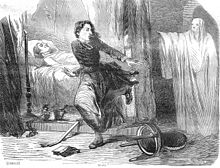
The adult female in white, a familiar figure in European ghost stories

The biblical Iv Horsemen of the Apocalypse. Conquest, with a bow, rides a white horse. Death rides a stake or lite dark-green horse (painting by Viktor Vasnetsov, 1887).
White is the colour associated with ghosts and phantoms. In the past the expressionless were traditionally buried in a white shroud. Ghosts are said to be the spirits of the dead who, for various reasons, are unable to residue or enter heaven, and and so walk the earth in their white shrouds. White is besides continued with the paleness of death. A common expression in English language is "pale as a ghost."[83]
The woman in white, Weiße Frau, or dame blanche is a familiar figure in English, German and French ghost stories. She is a spectral apparition of a female clad in white, in almost cases the ghost of an ancestor, sometimes giving warning well-nigh death and disaster. The almost notable Weiße Frau is the legendary ghost of the German Hohenzollern dynasty.
Seeing a white horse in a dream is said to be presentiment of death.[84] In the Book of Revelation, the terminal volume in the New Testament of the Bible, the Four Horsemen of the Apocalypse are supposed to announce the Apocalypse earlier the Last Sentence. The homo on a white horse with a bow and pointer, co-ordinate to different interpretations, represents either War and Conquest, the Antichrist, or Christ himself, cleansing the globe of sin. Decease rides a horse whose color is described in aboriginal Greek equally khlōros (χλωρός) in the original Koine Greek,[85] which can mean either dark-green/light-green-xanthous or pale/pallid.[86]
Opposite of black
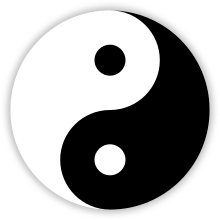
In Taoism, white represents the yang or male person energy, one of the ii complementary natures of the universe.
Black and white ofttimes represent the contrast betwixt low-cal and darkness, day and night, male and female, good and evil.
In taoism, the two complementary natures of the universe, yin and yang, are oftentimes symbolized in black and white, Aboriginal games of strategy, such as become and chess, use black and white to represent the two sides.
In the French monarchy, white symbolized the King and his ability par la grâce de Dieu ("by the grace of God") and in contrast blackness was the colour of the queen who according to the Salic Law which excluded women from the throne (and thus from power) could never become the ruling monarch.
Blackness and white also frequently represent formality and seriousness, as in the costumes of judges and priests, business concern suits, of formal evening dress. Monks of the Dominican Order wear a black cloak over a white habit. Until 1972, agents of the Federal Bureau of Investigation were informally required by FBI Director J. Edgar Hoover to wear white shirts with their suits, to projection the correct image of the FBI.[87]
Names taken from white
White is the source of more names for women in western countries than any other color.[88] Names taken from white include Alba, Albine (Latin). Blandine, Blanche and Blanchette (French); Bianca (Italian); Jennifer (Celt); Genevieve, Candice (from Latin Candida); Fenela, Fiona and Finola (Irish gaelic); Gwendoline, Gwenael, Nol(g)wen (white woman) (Celt), Nives (Spanish) and Zuria (Basque).[89]
In addition many names come from white flowers: Camille, Daisy, Lily, Lili, Magnolie, Jasmine, Yasemine, Leila, Marguerite, Rosalba, and others.
Other names come from the white pearl; Pearl, Margarita (Latin), Margaret, Margarethe, Marga, Grete, Rita, Gitta, Marjorie, Margot.
Temples, churches and government buildings
Since ancient times, temples, churches, and many government buildings in many countries accept traditionally been white, the colour associated with religious and civic virtue. The Parthenon and other ancient temples of Greece, and the buildings of the Roman Forum were mostly made of or clad in white marble, though it is now known that some of these aboriginal buildings were actually brightly painted.[90] The Roman tradition of using white rock for regime buildings and churches was revived in the Renaissance and peculiarly in the neoclassic style of the 18th and 19th centuries. White stone became the material of choice for authorities buildings in Washington D.C. and other American cities. European cathedrals were likewise usually built of white or light-colored stone, though many darkened over the centuries from smoke and soot.
The Renaissance architect and scholar Leon Battista Alberti wrote in 1452 that churches should be plastered white on the inside, since white was the only appropriate colour for reflection and meditation.[91] Traditional Cistercian architecture also places a high accent on white for like reasons.[92] Subsequently the Reformation, Calvinist churches in kingdom of the netherlands were whitewashed and sober inside, a tradition that was also followed in the Protestant churches of New England, such as Old Due north Church building in Boston.
-

Although the Parthenon in Athens (5th century BC) is white today, it was originally painted with many colors
-
Ethnography
People of the Caucasian race are often referred to just as white. The United States Census Bureau defines white people as those "having origins in whatsoever of the original peoples of Europe, the Center East, or Due north Africa. It includes people who reported "white" or wrote in entries such as Irish, German, Italian, Lebanese, Near Easterner, Arab, or Polish."[93] White people constitute the majority of the U.Due south. population, with a full of 204,277,273 or 61.6% of the population in the 2020 The states Demography.
White flag
A white flag has long been used to represent either surrender or a request for a truce. It is believed to have originated in the 15th century, during the Hundred Years' War between France and England, when multicolored flags, as well as firearms, came into common use by European armies. The white flag was officially recognized as a request to cease hostilities past the Geneva Convention of 1949.[94]
Vexillology and heraldry
In English language heraldry, white or silverish signified brightness, purity, virtue, and innocence.[95]
See besides
- Color realism
- List of colors
- Variations of white
Notes
- ^ Völz, Hans G.; Kischkewitz, Jürgen; Woditsch, Peter; Westerhaus, Axel; Griebler, Wolf-Dieter; De Liedekerke, Marcel; Buxbaum, Gunter; Printzen, Helmut; Mansmann. "Pigments, Inorganic". Ullmann's Encyclopedia of Industrial Chemistry. Weinheim: Wiley-VCH. doi:ten.1002/14356007.a20_243.pub2.
- ^ Eva Heller (2000), Psychologie de la couleur – effets ets symboliques, pp. 130–46
- ^ Eva Heller (2000), Psychologie de la couleur – effets ets symboliques, p. 137
- ^ Sanskrit-Dictionary.uni-koeln.de Archived 13 February 2010 at the Wayback Machine (Monier Williams Sanskrit-English Dictionary, p. 1106).
- ^ Max Vasmer, Этимологический словарь русского языка, т.3, Москва 1971, 575–76.
- ^ OED; Harper, Douglas (November 2001). "Online Etymology Dictionary". Retrieved 26 March 2008.
- ^ Varichon 2005, pp. eleven–12.
- ^ Michel Pastoureau (2005), Le petit livre des couleurs, p. 47
- ^ "Pigments through the Ages – Prehistory". Retrieved thirty December 2016.
- ^ a b Anne Varichon (2000), Couleurs – pigments et teintures dans les mains des peuples, p. sixteen .
- ^ Anne Varichon (2000), Couleurs – pigments et teintures dans les mains des peuples, p. 21.
- ^ John Gage (1993) Color and Culture, p. 29.
- ^ Kassia St. Clair (2016) The Hugger-mugger Lives of Colour, p. 43-44
- ^ Webster's New Earth Dictionary of the American Linguistic communication, (1964)
- ^ Stefano Zuffi (2012), Color in Art, pp. 224–25.
- ^ Stefano Zuffi (2012), Color in Art, pp. 226–27.
- ^ Stefano Zuffi, Color in Art, pp. 232–33.
- ^ John Gage, (1993), Color and Culture, pp. 117–nineteen.
- ^ Chronique des métropoles:Paris, p. 83, publ. Dargaud 2003
- ^ Roberts, Andrew, Napoleon – A Life, (2014), Viking Press, ISBN 978-0-670-02532-9, pp. 723–24
- ^ Michel Pastoureau (2005), Le petit livre des couleurs, pp. 50–51.
- ^ Stefano Zuffi (2012), Color in Fine art, p. 260.
- ^ Philip Ball (2001), Bright Globe, Art and the Invention of Colour, pp. 484–85.
- ^ Le Corbusier. Toward an Architecture. Translated by John Goodman. Los Angeles: Getty Research Plant, 2007
- ^ Wyszecki & Stiles. Color Scientific discipline (Second ed.). p. 506.
- ^ Kassia St. Clair (2016) The Hush-hush Lives of Color, p. 17
- ^ "Colours of calorie-free". Scientific discipline Learning Hub. Retrieved 4 April 2015.
- ^ "Color: White Low-cal, Reflection & Assimilation". study.com. Retrieved 4 April 2015.
- ^ a b Convex and non-convex illuminant constraints for dichromatic colour constancy, M.D. Finlayson and Grand. Schaefer, in Proceedings of the 2001 ee.EE Calculator Club Conference on Computer Vision and Pattern Recognition. CVPR 2001 doi:x.1109/CVPR.2001.990528 "the perceived color of an object is more or less independent of the illuminant; a white newspaper appears white both outdoors under bluish daylight and indoors under yellow tungsten calorie-free, though the responses of the eyes' colour receptors ... will be quite dissimilar for the two cases."
- ^ a b Program of Color Science / Munsell Colour Science Laboratory, Rochester Plant of Applied science, Complete Colour FAQ. "A perfect mirror reflects all of the light that strikes it... A perfect white as well reflects all the light incident on it, but reflects that light diffusely. In other words, the white scatters the incident light in all directions."
- ^ An Introduction to Appearance Analysis, Richard West. Harold, in GATFWorld, the mag of the Graphic Arts Technical Foundation, SS Number 84. "The typical reference is a white standard that has been calibrated relative to the perfect white reflecting diffuser (100% reflectance at all wavelengths)."
- ^ Wyszecki & Stiles. Color Science (Second ed.).
Regular reflection (or specular, or mirrorr reflection) follows the laws of optical reflection without diffusion (scattering), as exemplified by mirrors.
- ^ "Does hue touch on the perception of grayness?", R Shamey, W Sawatwarakul, Sha Fu, 13 May 2014, doi:10.1002/col.21894, Color Research & Awarding, Book 40, Effect 4, p. 374. http://onlinelibrary.wiley.com/doi/10.1002/col.21894/pdf Archived 8 October 2017 at the Wayback Motorcar "The usual definition of achromatic color is 'a perceived colour without hue.' The colorimetric definition is that of an object with a flat reflectance function at a given level of reflectance, or one of its metamers."
- ^ "17-11 achromatic color". International Commission on Illumination (CIE). 2014. Retrieved viii October 2017.
in the perceptual sense: perceived colour devoid of hue
- ^ "17-12 achromatic stimulus". International Commission on Illumination (CIE). 2014. Retrieved 8 October 2017.
- ^ "17-1427 white, adjusted". International Committee on Illumination (CIE). 2014. Retrieved 4 April 2015.
- ^ "Science of summertime – where does embankment sand come from?" Livescience.com
- ^ "Why Snow is White (Even Though H2o is Articulate)". Retrieved 30 December 2016.
- ^ Survey, U.S. Geological. "USGS Glacier Studies". Retrieved 30 Dec 2016.
- ^ "Why Are Clouds White?". Retrieved 30 Dec 2016.
- ^ "Pigments through the Ages – Overview – Lime white". Retrieved 30 December 2016.
- ^ Philip Ball (2000), Brilliant Earth, Art and the Invention of Colour, p. 99.
- ^ "Pigments through the Ages – Overview – Titanium white". Retrieved 30 December 2016.
- ^ Burdock, George A. (1997). Encyclopedia of Nutrient and Colour Additives. CRC Press. p. 2991. ISBN9780849394140.
- ^ Kassia St. Clair (2016) The Secret Lives of Color, p. 40
- ^ "Bleaching". Encyclopædia Britannicah (9th Edition (1875) and 10th Edition (1902) ed.). Retrieved 2 May 2012.
- ^ Field, Simon Q (2006). "Ingredients – Bleach". Science Toys . Retrieved 2 March 2006.
- ^ Bloomfield, Louis A (2006). "Sunlight". How Things Work . Retrieved 23 February 2012.
- ^ Eva Heller (2000), Psychologie de la couleur, effets et symboliques, p. 144
- ^ Richmond, M. "Late stages of evolution for low-mass stars". Lecture notes, Physics 230. Rochester Institute of Applied science. Retrieved 3 May 2007.
- ^ "Cosmic Detectives". The European Space Agency (ESA). 2 Apr 2013. Retrieved 26 Apr 2013.
- ^ Stellar Spectral Types Archived 2 January 2009 at the Wayback Machine, entry at hyperphysics.phy-astr.gsu.edu, accessed on line 19 June 2007.
- ^ "An Introduction to Mod Astrophysics" past B.W Caroll and D.A Ostlie 1996 edition, chapter 8
- ^ Empirical bolometric corrections for the main-sequence Archived 9 Nov 2017 at the Wayback Machine, 1000. G. H. J. Habets and J. R. Due west. Heintze, Astronomy and Astrophysics Supplement 46 (Nov 1981), pp. 193–237, Tables Vii and Viii.
- ^ Eva Heller (2000). Psychologie de la couleur, effets et symboliques, p. 132.
- ^ "Chapter 15: The Covenant of Baptism". Doctrines of the Gospel Teacher Manual. The Church of Jesus Christ of Latter-day Saints. Retrieved xvi December 2021.
- ^ "Preparing to Enter the Holy Temple". Preparing to Enter the Holy Temple. The Church of Jesus Christ of Latter-day Saints. Retrieved 16 December 2021.
- ^ "Lesson 5: Learning from the Lord through Symbols". Endowed from on High: Temple Preparation Seminar Teacher'due south Manual. The Church of Jesus Christ of Latter-day Saints. Retrieved 16 December 2021.
- ^ "Why Symbols?". Ensign. The Church of Jesus Christ of Latter-solar day Saints. Feb 2007. Retrieved 16 December 2021.
- ^ Hathaway, Jane (2012). A Tale of Ii Factions: Myth, Memory, and Identity in Ottoman Egypt and Yemen. SUNY Printing. pp. 96–97. ISBN978-0-7914-8610-8.
- ^ David and Michigo Young (2005), The Art of the Japanese Garden, p. 64
- ^ Whalen, William J. The Latter Day Saints in the Modern Day World 1962
- ^ Prophet, Elizabeth Clare The Great White Brotherhood in the Civilisation, History and Religion of America Summit University Press, 1975
- ^ Dreyfuss, Henry. Symbol Sourcebook: An Authoritative Guide to International Graphic Symbols.
- ^ Heller, Eva, Psychologie de la couleur, effets et symboliques, Pyramyd. pp. 136–37
- ^ Anne Varichon, (2000), Couleurs – pigments et teintures dans les mains des peuples, p. 33.
- ^ Eva Heller (2000), Psychologie de la Couleur – effets et symboliques, p. 136.
- ^ Eva Heller (2000), Psychologie de la Couleur – effets et symboliques, p. 84.
- ^ "Japanese Funeral". Retrieved xxx December 2016.
- ^ "Japanese Funeral Customs". Retrieved xxx December 2016.
- ^ Anne Varichon, (2000), Couleurs – pigments et teintures dans les mains des peuples, pp. 16–35.
- ^ "Magical Properties of Colors". Wicca Living . Retrieved 28 Jan 2021.
- ^ Waite, Arthur Edward, (1911). The Book of Formalism Magic. London:William Rider. p.154
- ^ "Flag Code of Republic of india" (PDF). Ministry building of Abode Diplomacy (India). Archived from the original (PDF) on 21 January 2013. Retrieved 22 March 2014.
- ^ [1] Archived 21 May 2016 at the Wayback Machine, Taoiseach.gov.ie, 2007. Retrieved 22 March 2014.
- ^ "White Plume". Etymonline.com. Retrieved half dozen June 2012.
- ^ Guardian review Archived six Jan 2017 at the Wayback Machine of We Will Not Fight...: The Untold Story of Earth War One's Careful Objectors by Will Ellsworth-Jones
- ^ Safire, William (9 November 1997). "On Linguistic communication; Gimme the Ol' White Shoe". The New York Times.
- ^ Smith, Douglas (2 October 2012). Former People: The Last Days of the Russian Elite. Macmillan. ISBN978-1-4668-2775-2.
- ^ Eva Heller (2000), Psychologie de la couleur – effets et symboliques.
- ^ Eva Heller (2000), Psychologie de la couleur – effets et symboliques, pp. 144–48
- ^ Eva Heller (2000), Psychologie de la couleur – effets et symboliques, pp. 135–36.
- ^ Eva Heller (2000), Psychologie de la couleur – effets et symboliques, p. 137.
- ^ Stefano Zuffi (2012), Color in Art, p. 254.
- ^ Codex Sinaiticus Archived 30 October 2013 at the Wayback Automobile, Rev 6:viii.
- ^ Henry George Liddell and Robert Scott, A Greek-English language Lexicon Archived 6 Apr 2014 at the Wayback Machine: χλωρός.
- ^ Lydon, Christopher, "J. Edgar Hoover Made the FBI Formidable With Politics, Publicity and Results," The New York Times obituary, 3 May 1972
- ^ Eva Heller (2000), Psychologie de la Couleur – effets et symboliques, p. 133.
- ^ Heller 2000, pp. 133–34.
- ^ John Cuff (1993), Couleur et Culture, pp. 11–29.
- ^ Stefano Zuffi, Colour in Art (2012), p. 244.
- ^ Sternberg, Maximillian (28 August 2018). "Cistercian Architecture". Retrieved 15 June 2021.
- ^ "The White Population: 2000" (PDF). United States Census Bureau. Baronial 2001. Retrieved x March 2011.
- ^ Stefano Zuffi (2012), Color in Art, p. 256.
- ^ American Girls Handy Book: How to Amuse Yourself and Others, by Adelia Beard. ISBN 978-0-87923-666-three, p. 369.
References
- Heller, Eva (2000). Psychologie de la couleur – Effets et symboliques. Pyramyd (French translation). ISBN978-two-35017-156-2.
- Varichon, Anne (2005). Couleurs – pigments et teintures dans les mains des peuples (in French). Editions de Seuil. ISBN978-2-02-084697-4.
- Zuffi, Stefano (2012). Color in Art. Abrams. ISBN978-ane-4197-0111-5.
- Gage, John (2009). La Couleur dans l'fine art. Thames & Hudson. ISBN978-2-87811-325-9.
- Pastoureau, Michel (2005). Le petit livre des couleurs. Editions du Panama. ISBN978-2-7578-0310-3.
- Ball, Philip (2001). Brilliant Earth – Art and the Invention of Color. Penguin Group. ISBN978-2-7541-0503-three.
- St. Clair, Kassia (2016). The Secret Lives of Color. London: John Murray. ISBN9781473630819. OCLC 936144129.
External links
| | Wikimedia Commons has media related to White. |
| | Look up white in Wiktionary, the free lexicon. |
Source: https://en.wikipedia.org/wiki/White









